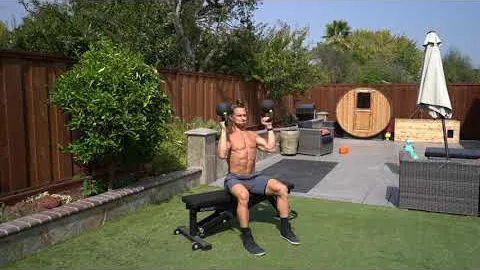
Are you looking to improve your upper body strength and stability? Look no further than the seated kettlebell press bottoms up exercise. This challenging yet effective exercise targets your shoulders, core, and stability muscles. In this article, we will dive deep into this exercise, its benefits, and how to perform it correctly.
Improved Shoulder Strength: The seated kettlebell press bottoms up exercise mainly targets the shoulders, helping to develop robust and well-rounded shoulder strength. This exercise engages the deltoids, specifically the anterior and lateral heads, as well as the trapezius and rhomboid muscles.
Increased Upper Body Stability: Performing the exercise in a seated position requires active engagement of your core muscles, increasing upper body stability. This stability translates into improved performance in other exercises and daily activities.
Enhanced Grip Strength: The bottoms up position, where the kettlebell handle faces upward, challenges your grip strength. By performing this exercise regularly, you can strengthen your grip, which is beneficial for various sports and activities.
Improved Overhead Range of Motion: The seated kettlebell press bottoms up exercise allows you to work through a full range of motion. Over time, this can lead to improved shoulder flexibility and mobility, promoting healthier shoulder joints.
Core Activation: Sitting on a stable surface forces your core muscles to engage to maintain proper posture throughout the exercise. This strengthens your core, leading to better trunk stability and reducing the risk of back pain.
Setup: Sit on a stable bench or chair with your back straight and feet flat on the floor. Grab a kettlebell with an appropriate weight for your strength level.
Starting Position: Hold the kettlebell by the handle with an overhand grip, positioning it at shoulder height. Ensure that the weighted part of the kettlebell is facing up towards the ceiling, known as the bottoms up position.
Pressing Movement: While maintaining a stable core, press the kettlebell straight up towards the ceiling, fully extending your arm. Keep your wrist straight and the kettlebell stable throughout the movement. Pause for a moment at the top.
Lowering Movement: Control the descent of the kettlebell back to the starting position in a slow and controlled manner. Maintain proper form and stability throughout the movement.
Repetitions and Sets: Perform 8-12 repetitions per set, depending on your fitness level and the weight of the kettlebell. Aim to complete 2-3 sets, resting for 60-90 seconds between sets to allow for recovery.
Before attempting this exercise, ensure that you have mastered the proper form and technique with a lighter weight kettlebell.
Pay close attention to your grip throughout the exercise, as a secure grip is essential for stability and safety.
Maintain a neutral spine and engage your core muscles to ensure proper posture throughout the exercise.
Start with a lighter kettlebell and gradually increase the weight over time as your strength and stability improve.
Consult with a fitness professional if you have any pre-existing shoulder conditions or concerns to ensure the exercise is safe for you.
The seated kettlebell press bottoms up exercise can be incorporated into your upper body or full-body strength training routine. Here are a few suggestions on how to include this exercise:
Upper Body Strength Workout: Perform the seated kettlebell press bottoms up exercise alongside other shoulder-focused exercises such as overhead presses, lateral raises, and bent-over rows.
Core and Stability Workout: Include the exercise in a workout that specifically targets core strength and stability. Combine it with planks, Russian twists, and other core exercises for a well-rounded routine.
Circuit Training: Add the seated kettlebell press bottoms up exercise to a circuit training workout, alternating it with exercises that target different muscle groups. This helps to increase overall strength and conditioning.
The seated kettlebell press bottoms up exercise is a versatile and challenging exercise that offers multiple benefits, including improved shoulder strength, upper body stability, grip strength, and core activation. By incorporating this exercise into your fitness routine, you can increase your upper body strength, improve stability, and enhance overall athletic performance. Remember to use proper form and gradually increase the weight as your strength and stability improve. Always consult with a fitness professional if you have any concerns or underlying medical conditions. Start reaping the benefits of the seated kettlebell press bottoms up exercise today and strengthen your way to a healthier, more functional body.
If you're looking for a gym, fitness club or yoga studio, you've come to the right place.
You can find information about gyms in your area. Browse catalog of gyms and find gyms with classes which are you looking for.
On gym page you can find simple information like address, phone or website. You can find list of available classes. You can check availability of personal training or small group classes. On place page you can also see information about open hours.
You can find gyms near you with amenities, courts, studios and equipments.
Use our map to find gym at your city or district.
In Gym Navigator you can find list of exercises with movies for many body parts.
You can browse exercises catalog and find exercises the best of you.
You can also find exercises grouped into workout plans, which you can use to improve you body. Each routine show you exercises one by one and give you possibility to count you progress and count down rest time.